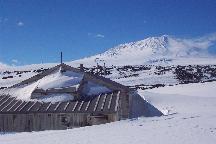
The hut is nevertheless much as Scott left it, and has been scrupulously perserved in recent times.
Approaching the hut.
To see it you have to request a key for the lock from personnel at
McMurdo. We had to scrape
away ice and snow from the sliding wood latch on the door. Upon entering
there is a brush arrrangement
on which to clean boots. Drifting snow covered several of the windows,
so there was only faint light.
We had to use a flashlight. It smelled old, and since there was little wind it was strangely quiet.
We hardly talked at all.
Here is the floor plan of the hut
Below, looking across the table to the crew's bunks. On the table
is one of the famous Primus stoves that figure prominently
in Shackleton's and Scott's narratives.
Some of the provisions in the galley.
I'm told the food is still edible. It reflects a typical Edwardian
kitchen, heavy on flavorful sauces.
Below, afficionados of low Reynolds number hydrodydnamics
will recognize the brand of syrup in the center of this picture.
Looking into the hut toward the darkroom.
Below, the laboratory
Looking into Scott's den and bunk. On the table the carcass
of an Emperor penguin is frozen in time. The magazine on the table
is an Illustrated London News from 1908.
A megaphone used for calling to crew out on the ice.
Below, the darkroom, created by the photographer Herbert Ponting.
He printed fine pictures from glass plates. The first movie shot
in Antarctica was developed here.
One of the crew's bunks, in a part of the hut know as
"the tenements". Most of the wire mesh supporting the mattress
has rusted away.
Penguin eggs in the storeroom.
Snowshoes for the 3 ponies housed in the stable in 1911.
In the center, a mousetrap.
The hand points to telegraphy equipment.
A stack of flensed seal blubber, used for fuel.
Below, a bicycle!
Leaning against the wall is a windsail used on the sledges.
Between the inner and outer wooden claddingsof the hut walls and
ceiling is an insulating layer of shredded seaweed sewn into jute
quiltng. Some of this is visible in the picture below.
Visible here is aa anchor of the Aurora. Erebus is in the
background, and on the right you can see a bit of the latrine.
The impression one gets is of a carefully planned structure,
a kind of McMurdo Station of 1911.